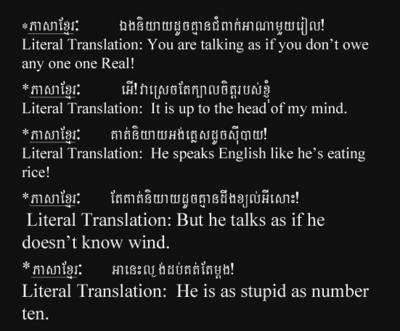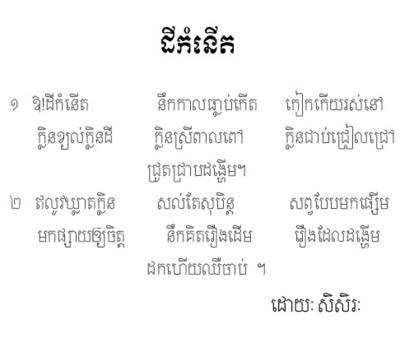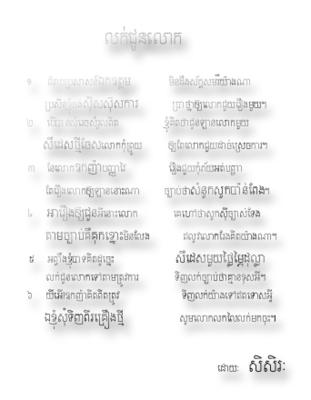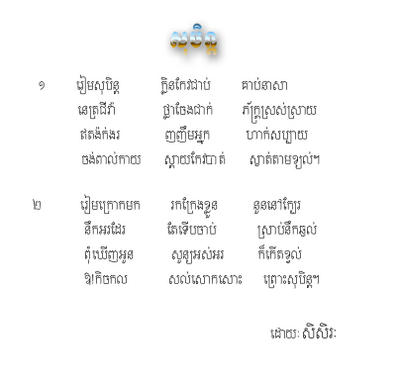My Seventh Poem: Lonesome Moon
5 Comments Published by seserak on Wednesday, August 31, 2005 at 6:09 PM.Picture of the Day: The Sea of Siem Riep
3 Comments Published by seserak on Tuesday, August 30, 2005 at 10:04 PM.
This picture was taken at West Baray, Siem Riep. The largest manmade reservoir of the ancient Khmers, the West Baray measures 8km by 2.1km. The lake construction project was started by King Suryavarman I (reigned 1001-1050) and completed by King Udayadityavarman II (reigned 1050-1066).
It looks just like the Sea of Kompong Som. So huge that I could hardly believe it was built 1000 years ago. And I have to agree it 's one of the greatest archivements of the Angkor Empire.
Khmer Fashion: The Khmer Kroma
4 Comments Published by seserak on Monday, August 29, 2005 at 3:20 AM. I found this Khmer Kroma's article quite interesting. Thought you might like it too. Here are a few excerpts:
I found this Khmer Kroma's article quite interesting. Thought you might like it too. Here are a few excerpts:The Khmer scarf, woven from cotton or silk, has been a fashion staple since Ancient times. While some claim the thin cloth, wrapped around one's head or neck, is used primarily to wipe the sweat from a hot face, others say wearing a kroma is as 'Khmer' as wearing a necktie is American.
[........]
Although its not nearly as popular as the western necktie, the traditional Khmer kroma appears to have international appeal. "When foreigners come to visit Cambodia, they sometimes pick up the Khmer style. They take the kroma to fold around their head like Khmer people in the countryside do," Srey Yar Phout Savdy said. Much to the delight of its guests, the Angkor Hotel in Siem Reap distributes the kroma as tourists check in.
[...]
Long or short, the multi-purpose kromas can be found in nearly every Cambodian household. Even babies know the benefits of the colorful scarves, as kromas are placed The Kromas also are used to shield children from the cold or dreaded mosquitoes. Adults too make use of the kromas in many ways, using them to clean their bodies or wear while taking a bath. As Cambodians head to work in the rice fields, they can be seen wearing a kroma folded around their head as a sun protector. The kroma has even kept the lustful stare of young boys off the faces of blushing girls.
For the whole article go to:
Whole article
Additional reading about Krama:
About Krama
Am I actually living in the dream of a butterfly?
3 Comments Published by seserak on Saturday, August 27, 2005 at 2:28 AM.Chuang Tzu dreamed that he was a butterfly.
All day long, he floated on the breeze
Without a thought of who he was or where he was going.
When he awoke, Chuang Tzu became confused.
"Am I a Man”, he thought, "who dreamed that I was a butterfly?
Or am I butterfly, dreaming that I am a man?
Perhaps my whole waking life is but a moment in a butterfly's dream!.
This is a story of transformation"
All day long, he floated on the breeze
Without a thought of who he was or where he was going.
When he awoke, Chuang Tzu became confused.
"Am I a Man”, he thought, "who dreamed that I was a butterfly?
Or am I butterfly, dreaming that I am a man?
Perhaps my whole waking life is but a moment in a butterfly's dream!.
This is a story of transformation"
(By Chuang Tzu, the great Toaist master of the fourth and the third century B.C)
Chuang-tzu dreams he's a butterfly,
and a butterfly becomes Chuang-tzu.
All of transformation this one body,
boundless occurrence goes on and on:
it’s no surprise Eastern seas become
western streams shallow and clear,
or the melon-grower at Ch'ing Gate
once reigned as Duke of Tung-ling.
Are hopes and dreams any different?
We bustle around, looking for what
and a butterfly becomes Chuang-tzu.
All of transformation this one body,
boundless occurrence goes on and on:
it’s no surprise Eastern seas become
western streams shallow and clear,
or the melon-grower at Ch'ing Gate
once reigned as Duke of Tung-ling.
Are hopes and dreams any different?
We bustle around, looking for what
( From the "Ancient Song", by Li Po, one of the greatest poets of China)
 * Kampong Speu Province, Cambodia: Bunna puts down his chalk. He has just finished explaining a math solution to his students. He glances at his watch.
* Kampong Speu Province, Cambodia: Bunna puts down his chalk. He has just finished explaining a math solution to his students. He glances at his watch.Ten past eleven.
All the classrooms at Tnol Bott Primary School are already empty, except for his. “Those who have completed all the note-takings can leave,” he says, turning toward his seemingly bored, tired, a little irritated, and ready-to leave-even-if-they-have-yet-to-complete-their-note-taking students. “By the way, is the rice cooked?”
It’s not an unusual question, and Bunna’s been repeating the same phrase during or after his session for almost a year now. The students, too, know the question well. Sometimes they’d tell him that it’s already cooked without even having to be asked.
About 20 met
 res away in front of Bunna’s class, lie several piles of bricks, arranged in two triangular shapes, an old dirty cooking pot, an old rusty, antique-like kettle, and a piece of used window covering the bricks.
res away in front of Bunna’s class, lie several piles of bricks, arranged in two triangular shapes, an old dirty cooking pot, an old rusty, antique-like kettle, and a piece of used window covering the bricks.His kitchen.
This is where the students cook him rice and boil him water. Adjacent to the “kitchen” lie two old dirty tables joint together;this place has no cover, nor roof. His open dining hall. This is where he has lunch and sometimes his dinner at night if he doesn’t return home.
His school---Tnol Bott Primary School---is located in a rather remote area of the province, 27 Km from the central town (where he lives) and 7 Km down from the National Road 4. Everyday he’d wake up early in the morning, pull out his second-hand Honda Daelim and drive 27 Km down to his school.
It usually takes him 40 minutes to reach his work place. The road to his school is still in its bad condition: bumpy and dusty in dry season; muddy and slippery in rainy season. He says the worst thing is when he has to sail his vehicle across the flooding road during some rainstorm days. Occasionally, though, when Bunna wakes up late, it takes him lesser time as he’d speed his Honda Daelim as fast as possible to get to school on time, no matter how dangerously bumpy or slippery the road is.
 He’s a new recruit. He’s been teaching here for only a year and a half, but he wanted to quit teaching since the first sixth month.
He’s a new recruit. He’s been teaching here for only a year and a half, but he wanted to quit teaching since the first sixth month.“Basically, all new primary school teachers like me earns as much as 70000 Riel (18$) a month,” Bunna explains, “but I have to spend 6000Riel (1.5$) a day on gasoline for going back and forth, not to mention the money I have to spend on lunch everyday. I see no gain in doing this. So, what's the point of continuing to teach?”
The school knows his problem; they are already in shortage of teachers. So, to encourage him to keep coming to school as well as to help reduce his every day’s expense , on a voluntarily basic, students agree---despite the fact that their families are so poor--- that each of them would bring one or two kilos of rice each month to school and cook for him. In one or two weeks some students would hand him one or two of their home-raised chickens as a bonus for his dinner.
Most of the students come from rural, impoverished families with low educational backgrounds. Yet, Bunna says he could still see in their eyes--- the eyes that hunger for knowledge and the need for proper education.
Being an educator himself, he says, he is very well aware of the value and the role of education. He doesn’t want to see those kids quitting school at such an early age. Yet, anywhere, anytime, hunger and basic needs seem to be ahead of every thing else.
“Even with the help of the school, I still could not support myself; meaning I still live on my parent’s money,” he says, “I feel the need to live a proper life, an ordinary life, if not a luxurious one, just like others.” With the salary as little as 18$ a month he knows his life is too far below the so-called “ordinary line.”
Hence he’s now divided between the ideas of staying on with the job waiting for the government to increase the salary, and finding a second job with just a slightly better salary and quit teaching.
There is, however, good news for Bunna. Last year the government promised to increase 15% of the total salary to all civil servants by 2006. But such a raise is too small for him and, as he says, “it won’t make any thing better.” He says he’d probably be much happier with the plan if he earned 2000$ a month just like all the Cambodian parliamentarians do.
The Cambodian Independent Teachers Association, which was founded in 2000 and now counts 2,500 teachers as members in several provinces, has urged the government to raise teacher salaries to $100 per month[The Cambodia Daily , WEEKEND Saturday, January 10-11 2004]. But prime minister Hun Sen mentioned again in a speech last month that the government is too poor to afford to do so. “If we want to raise 100$ for teachers, we’ll have to reduce the numbers of the whole teachers from 70000 to 10000,” he says.
Back to Tnol Bott Primary School, Bunna just got back from a nearby shop with a small plastic bag full of local foods in his hand. He usually spends about 1000Riels (0.3$) a day on food. “The foods are almost the same everyday, but the dining hall is cool, completely open with fresh and natural air,” he jokes.
But Bunna says he doesn’t know if he will have to buy the same food, have lunch on the same old dirty tables, drive the same old second hand Honda Daelim, and live on his parent’s money for the rest of his career. And yet for him the hope of getting 100$ a month seems far away.
Picture of the Day: My Friend's Nephew
2 Comments Published by seserak on Wednesday, August 10, 2005 at 11:29 PM.
Every language has its special expressions, slang as well as idioms. Some of these expressions, if translated word-for-word to another language, you’ll definitely find out that the results you got are surprisingly odd, nonsense, sometimes meaningless, and sometimes hilarious new phrases. Cambodian language is no exception. I’ve just tried word-for-word translation of some Khmer slang into English. And it confirms my above hypothesis. Below are the results: (Two of them are originally the work of Pheakdey Cheat, a funny, yet bright and intelligent friend of mine at IFL)
An Embarrassing Experience of Learning a Foreign Language
13 Comments Published by seserak on Tuesday, August 09, 2005 at 3:29 PM.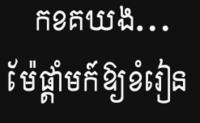 It happened whilst I was studying Japanese at a Foreign Language University.
It happened whilst I was studying Japanese at a Foreign Language University.It was Tuesday which by schedule was a conversation day, and the new subject was about animal and the sounds of animal. There were eight students in my class, three from Mongolia, two from Romania, one from Hungaria, another one from Philippine, and me from Cambodia. My teacher was asking every student to imitate the sounds of dogs barking in their respective languages.
On that day my eyes were kind of half-shut and half-open, as a result of late night party, chatting and drinking ; that is to say, I wasn’t quite following the teacher. All I heard were “bow-bow," " wow-wow," and "how-how." Those were actually the sounds of dogs barking in Hungarian, Romanian and Mongolian language. Then I heard the teacher said: “…It sounds like 'wan-wan'”. She then turned to me and said, “what does in sound like in your language?”
I caught only her final phrase “wan-wan” which was in fact the sound of Japanese dog makes when it barks, and I had no idea it sounds that way in Japanese. So I assumed she was asking me to pronounced number one in my own language, since "wan-wan" sounded somehow like "one-one."
“It sounds like 'mouy-mouy',” I replied.
“Mouy-mouy?”my teacher mimicked, looking a little surprised and suspicious.
“Are you sure it’s 'Mouy Mouy'?”
"I’m absolutely certain that it’s 'mouy-mouy'," I said.
Although I am a bit sleepy, I still remember my own language perfectly well, I thought.
Then she turned to other students and said,“they bark 'mouy-mouy!" Don’t you think Cambodian dogs are weird? ”
Now you can tell how embarrassed I felt. Of course, the dogs never bark "mouy-mouy." They make the sound " woh-woh," “wow-wow” or “bow-wow” just like Japanese, Romanian or American dogs!
Picture of the Day: Roast Beef with Prohok Sauce
9 Comments Published by seserak on Monday, August 08, 2005 at 12:46 AM.My Sixth Poem: Romdoul Or Sakura?
9 Comments Published by seserak on Sunday, August 07, 2005 at 5:16 PM.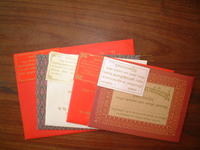 It was ten in the morning when my plane landed at Phnom Penh International Airport."The Hair Cutting Ceremony" from a wedding, held in a village nearby along National Road 4, was proceeding.
It was ten in the morning when my plane landed at Phnom Penh International Airport."The Hair Cutting Ceremony" from a wedding, held in a village nearby along National Road 4, was proceeding.As we started to drive off from the Airport heading toward our hometown- in Kampong Speu province-I took a glance at the scence of the wedding and found myself relaxing to the sound of Cambodian traditional wedding music that I hadn't heard for almost a year. " I am home", I said to myself, and smiled. Along the road, two hundred metres away, another " hair cutting ceremony" from another wedding was procceeding. "Two weddings", I thought.
As we drove pass the second wedding, the somewhat similar traditional wedding music from ahead was coming closer and closer. "Another wedding?", I felt rather amazed. And I was right; it was another wedding. Three weddings in just 500 metres away. " No surprise. It's wedding season", said my father as we drove past the third wedding.
It was early March and my third visit to Cambodia in three years. Wedding season begins in October and March is generaly the peak season. My hometown is some 40 kilometres away from Phnom Penh International Airport. I was busily doing wedding counting all the way from the airport until I got home. Three, four, five,six...then 18, 19, and as I reached my hometown I had 20 or so weddings, held along National Road 4 alone. Busy season. Everyone is getting married. To my surprise in my village there were two weddings on the same day.
It was 11:30AM when I eventually got home. 11:30AM: for weddings it was time for reception. My aunt who lives next door was waiting for me in her wedding-goers's dress. My mother too was wearing her traditional clothes, specially designed for wedding ceremonies. My uncle-in-law was also dressing up as if he was about to attend the wedding or other party. And surprisingly so was my cousin, who is my aunt's daughter.
" Big party for me?", I thought. "Or perhaps my mother and my aunt had been invited to one of her close relatives weddings?" In Cambodia you do not bring your spouse or your kids to a wedding with you unless you are a relative of the bride or the groom, or unless you are a special guest. But her explanation was quite different." I have three weddings today", she said, looking at her daughter and her husband. " So, I decided your uncle will attend one wedding, your sister (my cousin) will go to another wedding, and me, I'll go to another one". She said last month she got more than twenty invitations, some of which she was unable to attend, mainly because they were held on the same day. Since this month is the peak season, she expected more wedding invitations to come.
Weddings seemed to have ruined much of her time. A week or two before going to a wedding, she'd spend hours at the tailor ordering her new wedding clothes. " You can't just wear the same dress every time", she said. On the wedding day, she'd spend hours making up her face and her hair at the hairdresser. " Women are a little different from men", she told me, " you can't just take a bath, comb your hair, dress up in your same ordinary clothes and head to the wedding ceremony". Then she'd spend one hour at the receptions head table. Finally, she'd have to pay; that is, politely and generaly speaking, giving her wedding gift. No wedding is free - ever. Sometimes even when she does not wish to go or can't go, she still has to pay or else she'll risk losing face, losing her friends or losing her relatives.
She is not alone. My mother too. My friends's mother too. And as it seems, everyone.
The next day when I went in the market for T-shirt shopping I noticed the same conversation being discussed by market vendors. Everyone was talking about weddings. " His son is getting married tomorrow", someone said. " So tomorrow, I'm going to have 2 weddings". And then another voice replied:" You're luckier than me. She's not inviting you. I've got three and I don't know whose I'm going to attend and whose I'm going to abandon".
Time is probably the reason everyone is complaining about weddings. Weddings are time consuming. But the real reason is probably money - weddings are resource consuming. At the moment, in the centre of my province, each wedding gift is usually worth $10. Of course, the wedding gift is usually money, no material gifts unless the wedding belongs to the upper and richer class; for example, certain high ranking government officials; in which case a modern expensive car or jewelry is expected to be the wedding gift . In remote areas it is worth less than the urban area, probably $5 or even less. Whilst in Phnom Penh, wedding gifts are now usually worth $15 or higher as it represents the most advanced and richest area of the country. Suppose you are in the centre of my province, and you were invited to two wedding's reception on the same day. You'd have to give away $20. If your income is satisfactory, you probably wouldn't care much. But if you are a high school teacher whose salary is around $25, it seems you work the whole month only to support weddings. In fact, some of my friends are primary or high school teachers, who earn less than $2 a day. When wedding season comes they say they are terrified. They even joked that [ the wedding] is the cause of poverty. Weddings have turned out to be a sad and scary story, so to say.
But then there are the good sides of wedding invitations. " I keep complaining about having a lot of wedding invitations ", said my former high school literature teacher whilst I was visiting him. "But I keep attending. And in case it's a wedding of someone I know well but they failed to invite me, I'd be rather upset as I feel I am being forgotten". He said weddings have been one of our longest and oldest, valuable traditions. We Cambodians have the culture of helping each other, any where, on any occasion. Twenty five years ago when he got married, he invited his bachelor's friends. Later on, when they got married, he was the guest. Last year when his daughter got married, that friend was the guest. At the end of this year, the son of his friend will be married and he is expected to be the guest again.
Back home, my aunt had just returned from a nearby wedding reception. "The food today was really nice", she said. "We didn't have to cook today as all of our family members had their lunch at the wedding reception".
Well, that is probably another good point of wedding invitations. Today it is her turn. When her daughter gets married it will be their turn. So goes the circle and the tradition.
We keep counting the weddings, but we keep going. Wedding invitations are nothing bad, after all.



